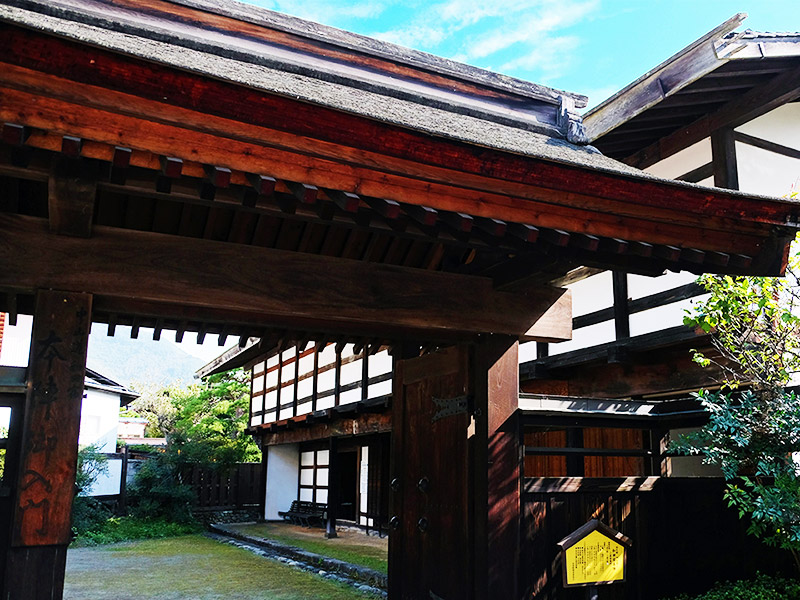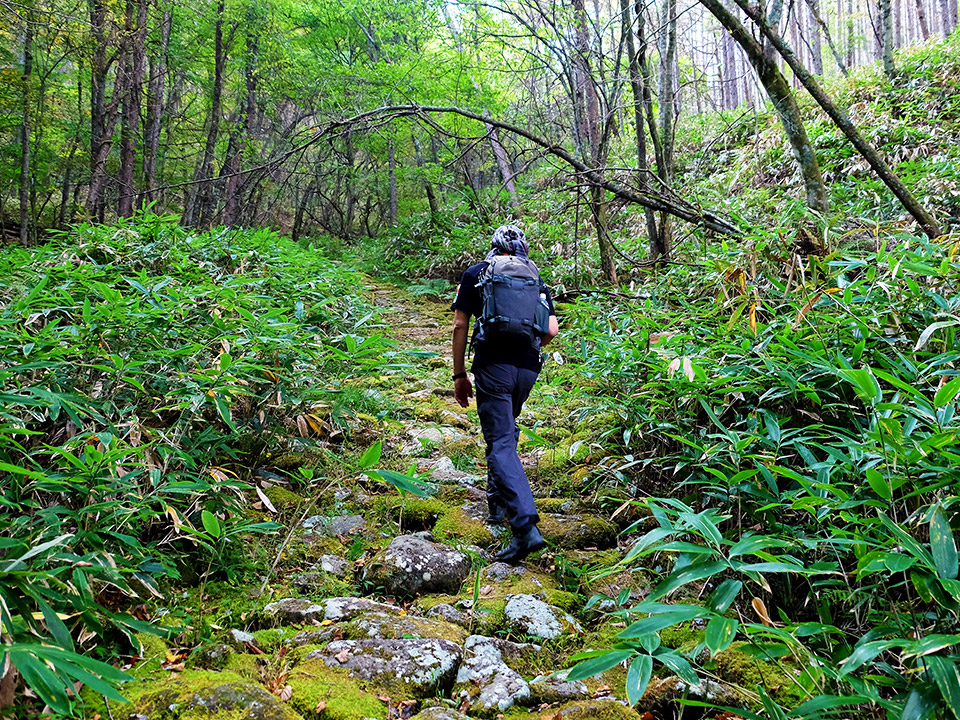Exploring the Longest Stretch of the Nakasendo
Visit the historic post towns of Wada-juku and Shimosuwa while hiking the Nakasendo's highest mountain pass on a beautifully preserved trail.
Update:2021/11/26

The Nakasendo is a historic highway running through the heart of Japan, utilized during the Edo Period (1603-1868) to travel between the former, imperial capital of Kyoto and the Tokugawa shogunate's newly installed seat of power in Edo (Tokyo). It spanned a distance of more than 530 kilometers and passed through a total of 69 post towns offering lodging and supplies.

Though much of the route has been lost to modernization, some sections of restored trail, as well as a number of preserved post towns, still remain, providing visitors with an opportunity to experience Japan as it looked and felt centuries ago.

One such spot is central Nagano's Wada-juku post town and the splendid trek on the original trail over the mountain pass of the same name—the longest section of the Nakasendo. Combining this excellent walk with a trip to the nearby post town of Shimosuwa for some fantastic sightseeing is the perfect way to maximize your time and Nakasendo experience. The hike itself can be done in a day, but you’ll want to budget two days if including Shimosuwa.

Exploring the Post Town of Wada-juku

Wada was the 28th post town on the Nakasendo when traveling in the direction of Kyoto. Today it's a charming countryside settlement that, upon first glance, seems rather unassuming. Yet, a walk down its quiet streets reveals plenty of clues pointing to its extraordinary history; particularly the wonderful wooden structures dating back 150 or more years that served travelers on their weeks-long journey from one end of the country to the other.

Wada was an especially important waypoint for two reasons. It's said that almost all travelers on the Nakasendo would spend a night here due to its location at the foot of a difficult mountain pass, and because of the great span separating it from the neighboring post town of Shimosuwa. The 69 stations of the Nakasendo were situated at an average of 8 kilometers apart, but nearly triple that distance (22 kilometers) stood between Wada and Shimosuwa.

It was a vibrant, expansive settlement with more than 100 lodges and 70 tea houses hugging both sides of the street in a continuous row that extended for nearly one kilometer, once the largest of Nagano's 26 post towns. Amongst these was a single honjin inn, a luxury guesthouse reserved for the exclusive use of the highest-ranking daimyo and dignitaries, which now serves as a museum and is Wada's top attraction.

Hiking the Nakasendo and Wada Pass

The entire hike from Wada-juku to Shimosuwa via Wada Pass is around 22 kilometers with nearly 800 meters of elevation gain on a mix of road and trail and takes over 9 hours. It is possible to cut out the road portions, as I did on my visit, but if you plan to do so be aware that transportation options to and from the trailheads are limited and tricky to navigate. Below is the description of the abbreviated version of the walk that follows only the 8-kilometer section of preserved forest trail up and down the pass.
Details
Distance: Approximately 8 kilometers
Elevation Gain: Approximately 650 meters
Average Time to Complete: About 4 to 4.5 hours

Wada Pass crests at an elevation of 1,600 meters, making it the highest point on the entire Nakasendo and an 800-meter climb from either of the two post towns that flank it. As mentioned, it was also one of the route’s most demanding stretches since 11 kilometers of ascent/descent lay on either side before the next main lodging and supply point.

The trailhead from which the restored walking path leaves the main road and begins its approach to the pass is located around 6 kilometers to the southwest of Wada-juku. On my visit, our wonderful guide Mr. Koshi arranged for transport by taxi from honjin to the start of the trail to save time and energy and avoid the long section of road to get there. By doing so we were able to start out at 1,100 meters of elevation rather than 800 meters.

The trail cuts through a pleasant forest, running parallel to and below a winding road, though not close enough to be a bother. It’s well-maintained and easy to follow, with plenty of signs marking the way. The path is also generously wide underfoot, which serves as a subtle reminder that noblewomen and other high-ranking officials were once carried along on the shoulders of others in the comfort of covered litters known as kago, necessitating that the trail be a minimum of 1.8 meters wide.

A definite highlight is an area where the original paving stones still remain in place, like silent mossy sentinels proudly standing watch for the last several hundred years. It’s things like this that really bring the trail and its rich history to life and set it apart from an ordinary hike, and it's the lack of tourists that set it apart from other parts of the Nakasendo.

In this direction, the ascent is gradual, with the gradient constant at around 10%. The trail briefly crosses over the road several times before arriving at a roadside eatery popular with motorists making the scenic drive along the Venus Line. This is a great place to stop and have some fresh soba, mushroom soup, and other regional and seasonal specialties.

From there it’s a short 700 meters to the broad, flat pass with a few scattered monuments and signs. On a clear day, there are great views of the distant Mt. Ontake and the plains surrounding Lake Suwa. This is the high point in the geographical sense, but the descent down the backside of the pass continues to take you through more inviting terrain and eventually merges with an attractive river where the sound of running water plays the same soundtrack heard by generations of travelers.

Our hike ended not far from here at a spot where the old Nakasendo highway merges with modern highway 142, and we were whisked away to Shimosuwa by another taxi hailed in advance by our guide. From here it would be possible to continue walking to town, but the route stays on paved roads the rest of the way.
Arriving in the Spiritual Town of Shimosuwa

Shimosuwa was unique as the Nakasendo’s only post town with hot springs, and for serving as the terminus of the Koshu Kaido, another one of the five Gokaido roads of the period. The Koshu Kaido connected Edo with Kai Province (Yamanashi) before merging with the Nakasendo, and Shimosuwa's location at the convergence of these two main highways along with its healing hot springs all but ensured its status as a popular and prosperous town.
These days the old post-town doesn't look much like its former self; instead, one notices a clean, contemporary townscape. Yet, the area around JR Shimosuwa Station is attractive, and there are several outstanding sightseeing destinations on or close to the Nakasendo that shouldn't be missed.
Suwa Taisha Shimosha Harumiya and Akimiya Shrines

Suwa Taisha is one of Japan's oldest and most important shrines, so influential that it has spawned a network of thousands of affiliates across the country. This taisha, or ‘grand shrine,' is composed of four main shrines, of which two (Harumiya and Akimiya) are located here in Shimosuwa and are collectively known as Shimosha or the lower shrine. Suwa Taisha has been around since at least the 7th century and the details of its history are exceedingly complex, but the beauty of the architecture and the special atmosphere of the grounds are easily appreciated.
Manji no Sekibutsu

It’s safe to say this 17th-century stone statue of Buddha is unlike any you’ve seen before, in Japan or elsewhere. Its unbalanced features and unfinished appearance seem almost amateurish at first glance, but they’re the reason you can’t look away, and the more you stare the more captivated you become.
The story of its creation is equally fascinating. A stonemason contracted to carve a torii gate for the nearby Harumiya Shrine chose this large boulder for the job, but as his chisel pierced the rock, blood began to pour from it. The confused and frightened artisan abandoned his plans and instead sculpted the sacred stone into this image of the Buddha, dedicating it in 1660. You can find this intriguing piece a short 5-minute walk from the Harumiya Shrine.
Jiunji Temple

Jiunji is a spectacular and secluded zen temple with over 700 years of history and whose current buildings date from the Nakasendo era. It features a picturesque, cedar-lined approach, elegant, understated architecture, meticulously-maintained grounds, and no crowds to spoil the ambiance—or your photos. It’s a wonderful place to take a slow, thoughtful stroll, or to sit and think about everything and nothing all at the same time. Finding a more impressive temple with less fanfare just might be impossible, and if you’re in the Shimosuwa area it’s a must-visit site.
Honjin Iwanami House

The Honjin Iwanami House is an incredible repository of priceless history. As Shimosuwa’s honjin, it was the accommodation for royalty and visitors of the highest class and welcomed a remarkable array of distinguished guests over the years. Evidence of these visits still exist in the form of sekifuda, wooden or paper placards that were brought by the guests and placed at the entrance of the residence to signify who would be staying and for how long.

Perhaps most notably the Meiji Emperor himself paid a visit in 1880, not stopping overnight, but staying long enough for a meal in the garden-view tatami room. During the 1600 to 1800s, it was forbidden for anyone lower than daimyo status to even set foot on the grounds, but now it’s open to the general public and you have the option of enjoying matcha and manju in the very same place that the emperor once sat.

Mr. Iwanami, the gentleman who presides over the manor, is the 28th generation in charge of the honjin and can fill your ear with captivating stories about the place and the significance of the many artifacts on display, as well as his prominent family’s inspiring exploits. Sipping your tea and looking out over the immaculate garden that remains unchanged since the ancient highway’s heyday, while reflecting on your personal Nakasendo journey is the perfect way to wrap up an unforgettable experience.




